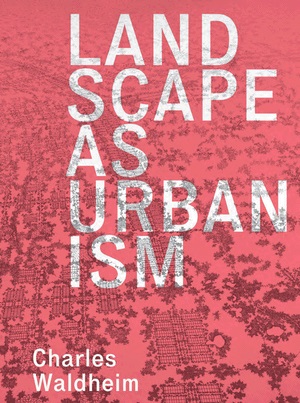Main author
Michael BrooksCharles Waldheim - Landscape as Urbanism: A General Theory
Charles Waldheim – ‘Landscape as Urbanism: A General Theory’
Published by Princeton University Press (2016)
In ‘Landscape as Urbanism’, author Charles Waldheim claims to have presented the first monographic account of a subject that has grown in prominence from a position of relative academic obscurity over the last decade-or-so. Waldheim , who is Professor and Chair of Landscape Architecture at Harvard University attempts to place landscape urbanism within the context of a broader set of historical, theoretical, and cultural conditions and proposes ‘a general theory for thinking the city through the medium of landscape.’
As an approximate definition, he suggests landscape urbanism is the theory of urban planning through the medium of landscape. It promotes the general idea that cities are best planned and organised, not through building and infrastructure design, but through the design of landscape.
In ‘Landscape as Urbanism’, Waldheim seeks nothing less than to establish the landscape architect as the urbanist of the age. Indeed, he presents a case early on, that ‘...the fundamental assumption that planning is the medium through which public policy and community participation are brokered may also be open for debate.’
Over the course of several chapters in this comprehensive book, Waldheim traces the history of landscape as a form of urbanism, from the Renaissance, through the dense industrial cities of the 19th century, to the early-20th century Fordist industrial economy, where landscape was reconceived as a medium of ecological planning. He states that in the contemporary post-Fordist industrial economy, ‘…landscape urbanism promises to clean the sites of the formerly industrial economy while integrating ecological function into the spatial and social order of the contemporary city.’
In so doing, Waldheim certainly makes a strong case for landscape urbanism, and, arguably, its inevitability. Perhaps such theories will become more prevalent and mainstream as people continue to densify in urban megacities over the next few decades.
The heavy text is scattered with generous illustrations that offer some interpretive clarity to what can become a vague and confusingly abstract subject. Mindful of this common criticism of the theory, with scant few real-life physical examples to draw from, the book includes works from around the world by designers such as Andrea Branzi, Frank Lloyd Wright, Michael Van Valkenburgh, and Ludwig Hilberseimer.
The thoroughness and depth of thought that Waldheim brings to this book and its ideas can feel rather like grappling with a piece of deconstructivist theory from the likes of Jacques Derrida or Jean Baudrillard. While this isn’t unnecessarily a bad thing, it can be more onerous and weighted down by academic verbiage than it needs to be, or ought to be for something purporting to be a ‘general theory’.
While those familiar with landscape urbanism will find a lot to appreciate in this intelligent and well-presented book, it may not succeed in enlightening a wider audience about this important but nuanced subject matter.
You can find out more and order the book here.
[edit] Find out more
[edit] Related articles on Designing Buildings Wiki:
- An Introduction to Passive House - review.
- BIM for Dummies - an interview.
- Biomimicry in Architecture - review.
- Brutalist London Map - review.
- ‘England’s Post-War Listed Buildings’.
- James Crawford - Fallen Glory.
- Landscape architect.
- Landscape urbanism.
- Last Futures: Nature, Technology and the End of Architecture.
- Living in the hyperreal post-modern city.
- London by Design - review.
- Manual of Section - review.
- Owen Hatherley interview.
- Owen Hatherley - Landscapes of Communism.
- Urban design.
Featured articles and news
Infrastructure that connect the physical and digital domains.
Harnessing robotics and AI in challenging environments
The key to nuclear decommissioning and fusion engineering.
BSRIA announces Lisa Ashworth as new CEO
Tasked with furthering BSRIA’s impressive growth ambitions.
Public buildings get half a million energy efficiency boost
£557 million to switch to cleaner heating and save on energy.
CIOB launches pre-election manifesto
Outlining potential future policies for the next government.
Grenfell Tower Inquiry announcement
Phase 2 hearings come to a close and the final report due in September.
Progress from Parts L, F and O: A whitepaper, one year on.
A replicated study to understand the opinion of practitioners.
ECA announces new president 2024
Electrical engineer and business leader Stuart Smith.
A distinct type of countryside that should be celebrated.
Should Part O be extended to existing buildings?
EAC brands heatwave adaptation a missed opportunity.
Definition of Statutory in workplace and facilities management
Established by IWFM, BESA, CIBSE and BSRIA.
Tackling the transition from traditional heating systems
59% lack the necessary information and confidence to switch.
The general election and the construction industry
As PM, Rishi Sunak announces July 4 date for an election.
Eco apprenticeships continue help grow green workforce
A year after being recognised at the King's coronation.
Permitted development rights for agricultural buildings
The changes coming into effect as of May 21, 2024.
























Comments
A useful article.